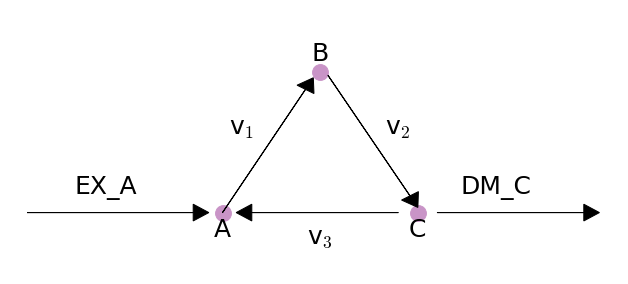9. Loopless FBA¶
The goal of this procedure is identification of a thermodynamically consistent flux state without loops, as implied by the name.
Usually, the model has the following constraints.
However, this will allow for thermodynamically infeasible loops (referred to as type 3 loops) to occur, where flux flows around a cycle without any net change of metabolites. For most cases, this is not a major issue, as solutions with these loops can usually be converted to equivalent solutions without them. However, if a flux state is desired which does not exhibit any of these loops, loopless FBA can be used. The formulation used here is modified from Schellenberger et al.
We can make the model irreversible, so that all reactions will satisfy
We will add in boolean indicators as well, such that
We also want to ensure that an entry in the row space of S also exists with negative values wherever v is nonzero. In this expression, \(1-i\) acts as a not to indicate inactivity of a reaction.
We will construct an LP integrating both constraints.
Note that these extra constraints are not applied to boundary reactions which bring metabolites in and out of the system.
In [1]:
%matplotlib inline
import plot_helper
import cobra.test
from cobra import Reaction, Metabolite, Model
from cobra.flux_analysis.loopless import construct_loopless_model
from cobra.solvers import get_solver_name
We will demonstrate with a toy model which has a simple loop cycling A -> B -> C -> A, with A allowed to enter the system and C allowed to leave. A graphical view of the system is drawn below:
In [2]:
plot_helper.plot_loop()

In [3]:
test_model = Model()
test_model.add_metabolites(Metabolite("A"))
test_model.add_metabolites(Metabolite("B"))
test_model.add_metabolites(Metabolite("C"))
EX_A = Reaction("EX_A")
EX_A.add_metabolites({test_model.metabolites.A: 1})
DM_C = Reaction("DM_C")
DM_C.add_metabolites({test_model.metabolites.C: -1})
v1 = Reaction("v1")
v1.add_metabolites({test_model.metabolites.A: -1, test_model.metabolites.B: 1})
v2 = Reaction("v2")
v2.add_metabolites({test_model.metabolites.B: -1, test_model.metabolites.C: 1})
v3 = Reaction("v3")
v3.add_metabolites({test_model.metabolites.C: -1, test_model.metabolites.A: 1})
DM_C.objective_coefficient = 1
test_model.add_reactions([EX_A, DM_C, v1, v2, v3])
While this model contains a loop, a flux state exists which has no flux through reaction v3, and is identified by loopless FBA.
In [4]:
construct_loopless_model(test_model).optimize()
Out[4]:
<Solution 1000.00 at 0x7fc7bd7a3b38>
However, if flux is forced through v3, then there is no longer a feasible loopless solution.
In [5]:
v3.lower_bound = 1
construct_loopless_model(test_model).optimize()
Out[5]:
<Solution 'infeasible' at 0x7fc7bd550208>
Loopless FBA is also possible on genome scale models, but it requires a capable MILP solver.
In [6]:
salmonella = cobra.test.create_test_model("salmonella")
construct_loopless_model(salmonella).optimize(solver=get_solver_name(mip=True))
Out[6]:
<Solution 0.38 at 0x7fc7b6d2d048>
In [7]:
ecoli = cobra.test.create_test_model("ecoli")
construct_loopless_model(ecoli).optimize(solver=get_solver_name(mip=True))
Out[7]:
<Solution 0.98 at 0x7fc7b74ad240>